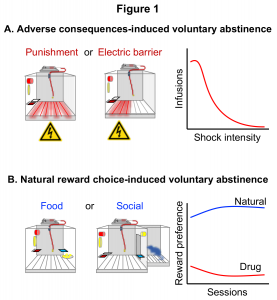 Reviews To Read – July 2021.
Reviews To Read – July 2021.
Our review describes recently developed rat models of relapse after voluntary abstinence, achieved either by introducing adverse consequences to drug taking or seeking or by providing mutually exclusive choices between the self-administered drug and nondrug rewards. We discuss recent neuropharmacological findings from studies using these models, future directions, and clinical implications.
Fredriksson, Ida; Venniro, Marco; Reiner, David J; Chow, Jonathan J; Bossert, Jennifer M; Shaham, Yavin
Animal Models of Drug Relapse and Craving after Voluntary Abstinence: A Review Journal Article
In: Pharmacological Reviews, vol. 73, no. 3, pp. 1050–1083, 2021, ISSN: 0031-6997.
@article{Fredriksson1050,
title = {Animal Models of Drug Relapse and Craving after Voluntary Abstinence: A Review},
author = {Ida Fredriksson and Marco Venniro and David J Reiner and Jonathan J Chow and Jennifer M Bossert and Yavin Shaham},
editor = {Michael Nader},
url = {https://pubmed.ncbi.nlm.nih.gov/34257149/},
doi = {10.1124/pharmrev.120.000191},
issn = {0031-6997},
year = {2021},
date = {2021-01-01},
urldate = {2021-01-01},
journal = {Pharmacological Reviews},
volume = {73},
number = {3},
pages = {1050--1083},
publisher = {American Society for Pharmacology and Experimental Therapeutics},
abstract = {Relapse to drug use during abstinence is a defining feature of addiction. During the last several decades, this clinical scenario has been studied at the preclinical level using classic relapse/reinstatement models in which drug seeking is assessed after experimenter-imposed home-cage forced abstinence or extinction of the drug-reinforced responding in the self-administration chambers. To date, however, results from studies using rat relapse/reinstatement models have yet to result in Food and Drug Administration–approved medications for relapse prevention. The reasons for this state of affairs are complex and multifaceted, but one potential reason is that, in humans, abstinence is often self-imposed or voluntary and occurs either because the negative consequences of drug use outweigh the drugtextquoterights rewarding effects or because of the availability of nondrug alternative rewards that are chosen over the drug. Based on these considerations, we and others have recently developed rat models of relapse after voluntary abstinence, achieved either by introducing adverse consequences to drug taking (punishment) or seeking (electric barrier) or by providing mutually exclusive choices between the self-administered drug and nondrug rewards (palatable food or social interaction). In this review, we provide an overview of these translationally relevant relapse models and discuss recent neuropharmacological findings from studies using these models. We also discuss sex as a biological variable, future directions, and clinical implications of results from relapse studies using voluntary abstinence models. Our main conclusion is that the neuropharmacological mechanisms controlling relapse to drug seeking after voluntary abstinence are often different from the mechanisms controlling relapse after home-cage forced abstinence or reinstatement after extinction.Significance Statement This review describes recently developed rat models of relapse after voluntary abstinence, achieved either by introducing adverse consequences to drug taking or seeking or by providing mutually exclusive choices between the self-administered drug and nondrug rewards. This review discusses recent neuropharmacological findings from studies using these models and discusses future directions and clinical implications.},
keywords = {},
pubstate = {published},
tppubtype = {article}
}
Relapse to drug use during abstinence is a defining feature of addiction. During the last several decades, this clinical scenario has been studied at the preclinical level using classic relapse/reinstatement models in which drug seeking is assessed after experimenter-imposed home-cage forced abstinence or extinction of the drug-reinforced responding in the self-administration chambers. To date, however, results from studies using rat relapse/reinstatement models have yet to result in Food and Drug Administration–approved medications for relapse prevention. The reasons for this state of affairs are complex and multifaceted, but one potential reason is that, in humans, abstinence is often self-imposed or voluntary and occurs either because the negative consequences of drug use outweigh the drugtextquoterights rewarding effects or because of the availability of nondrug alternative rewards that are chosen over the drug. Based on these considerations, we and others have recently developed rat models of relapse after voluntary abstinence, achieved either by introducing adverse consequences to drug taking (punishment) or seeking (electric barrier) or by providing mutually exclusive choices between the self-administered drug and nondrug rewards (palatable food or social interaction). In this review, we provide an overview of these translationally relevant relapse models and discuss recent neuropharmacological findings from studies using these models. We also discuss sex as a biological variable, future directions, and clinical implications of results from relapse studies using voluntary abstinence models. Our main conclusion is that the neuropharmacological mechanisms controlling relapse to drug seeking after voluntary abstinence are often different from the mechanisms controlling relapse after home-cage forced abstinence or reinstatement after extinction.Significance Statement This review describes recently developed rat models of relapse after voluntary abstinence, achieved either by introducing adverse consequences to drug taking or seeking or by providing mutually exclusive choices between the self-administered drug and nondrug rewards. This review discusses recent neuropharmacological findings from studies using these models and discusses future directions and clinical implications.
